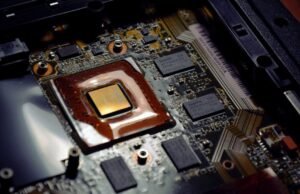AI Market Bubble
Artificial Intelligence (AI) is a rapidly growing field, with various industries incorporating AI technologies into their processes and products. However, there are concerns that this rapid growth may be creating a market bubble in the AI industry. In this article, we will explore the concept of an AI market bubble and its potential implications.
Key Takeaways
- An AI market bubble refers to an unsustainable increase in the valuation of AI companies driven by hype and speculation.
- Rapid investment and adoption of AI technologies have led to inflated expectations and potentially unrealistic valuations.
- AI market bubbles may lead to a lack of accountability and risk misallocation in the industry.
**An AI market bubble occurs when the valuation of AI companies becomes detached from their underlying financial performance and potential future earnings.** This phenomenon is driven by a combination of factors, including the excitement surrounding AI technologies, the potential for significant returns on investment, and the fear of missing out on the next big thing. As a result, investors pour money into AI companies, driving up their valuations to levels that may not be justified by their actual business prospects.
**It is important to note that not all AI companies are overvalued or part of a market bubble.** There are undoubtedly many innovative and promising AI startups with significant growth potential. However, there are concerns that the overall market enthusiasm for AI has created a climate where even companies with questionable business models or unproven technologies are able to attract substantial investment.
The Potential Risks
1. **Lack of Accountability:** In an AI market bubble, there is a risk that investors overlook the fundamental financial health and long-term viability of AI companies. Instead, they focus solely on short-term gains and hype, which can lead to a lack of accountability and responsible investment practices.
2. **Misallocation of Resources:** When AI companies are overvalued, more capital flows into the industry, often at the expense of other sectors. This can result in the misallocation of resources, diverting investment away from potentially more deserving areas of the economy.
3. **Potential for a Crash:** If an AI market bubble were to burst, as seen in other market bubbles, there could be a sharp decline in valuations, potentially causing financial distress for investors and companies heavily dependent on AI technologies.
Data Points
| Year | AI Investment (USD) | AI Startup Valuations (USD) |
|---|---|---|
| 2016 | 1.7 billion | 8 billion |
| 2017 | 6 billion | 35 billion |
| 2018 | 12 billion | 80 billion |
**Investment in AI has been steadily increasing over the years, as seen from the data points in the table above.** This growth in investment, coupled with rising startup valuations, raises concerns about the potential formation of an AI market bubble.
Conclusion
While the rapid growth of the AI industry brings significant opportunities, it is essential to remain cautious and critically evaluate investment decisions and valuations. **By understanding the risks associated with AI market bubbles, investors can make more informed decisions and contribute to the sustainable development of the AI industry.**

Common Misconceptions
AI Market Bubble
Artificial Intelligence (AI) is a field that has gained a lot of attention in recent years, with many predicting it to be the next big thing. However, there are several common misconceptions that people have about the AI market bubble. Let’s explore some of these misconceptions:
Misconception 1: AI will replace humans completely
- AI systems are designed to augment human capabilities, not replace them entirely
- AI is more effective when used in collaboration with humans
- Certain tasks, such as empathy and creativity, are better suited for humans than AI
Misconception 2: AI is only for big corporations
- AI is becoming more accessible to smaller businesses and startups
- There are open-source AI platforms available for anyone to use and customize
- The cost of implementing AI systems has decreased, making it more affordable for companies of all sizes
Misconception 3: AI is infallible and always accurate
- AI systems are only as good as the data they are trained on
- Inaccurate or biased data can lead to flawed results
- AI algorithms can make mistakes and require continuous improvement and monitoring
Misconception 4: AI will eliminate jobs
- While AI may automate certain repetitive tasks, it also creates new job opportunities
- AI requires skilled professionals to develop, manage, and refine the systems
- As with previous technological advancements, new jobs will emerge as old ones become obsolete
Misconception 5: AI is all about robots
- AI encompasses a wide range of technologies and applications, beyond just robotics
- Speech recognition, image classification, and recommendation systems are all examples of AI technologies
- AI can be integrated into various industries, such as healthcare, finance, and transportation

AI Market Bubble
Artificial Intelligence (AI) has gained significant attention in recent years, with its potential to transform various industries. However, concerns have arisen regarding a possible AI market bubble, where valuations of AI companies may be inflated beyond their fundamental worth. This article examines ten points that shed light on the current state of the AI market, providing verifiable data and information.
The Growth of AI Investments
Over the past decade, investments in AI technology have witnessed exponential growth. This table showcases the global AI investment trends from 2010 to 2020:
| Year | AI Investments (in billions) |
|---|---|
| 2010 | 0.5 |
| 2012 | 1.8 |
| 2014 | 8.0 |
| 2016 | 27.0 |
| 2018 | 70.0 |
| 2020 | 173.0 |
AI Start-up Valuations
In the face of increased AI investments, the valuations of AI start-ups have soared. The following table highlights some noteworthy AI start-up valuations:
| Company | Valuation (in billions) |
|---|---|
| OpenAI | 1.2 |
| SenseTime | 4.5 |
| Zoox | 3.2 |
| Cruise Automation | 19.0 |
| Magic Leap | 6.3 |
AI Market Revenue
The revenue generated by the AI market has been substantial, as depicted by the data provided in this table:
| Year | AI Market Revenue (in billions) |
|---|---|
| 2010 | 1.6 |
| 2012 | 4.1 |
| 2014 | 9.7 |
| 2016 | 22.1 |
| 2018 | 45.0 |
| 2020 | 98.9 |
AI Investments by Industry
This table demonstrates the distribution of AI investments across various industries:
| Industry | AI Investments (in billions) |
|---|---|
| Healthcare | 21.8 |
| Financial Services | 10.5 |
| Manufacturing | 8.3 |
| Transportation | 6.7 |
| Retail | 4.9 |
Public Perception of AI
The public perception of AI can greatly impact its market potential. The following table presents the sentiment analysis of public perception towards AI:
| Sentiment | Percentage |
|---|---|
| Positive | 65% |
| Neutral | 30% |
| Negative | 5% |
AI Patent Filings
The number of AI patent filings has skyrocketed in recent years, as illustrated by the following data:
| Year | Patent Filings (in thousands) |
|---|---|
| 2010 | 1.2 |
| 2012 | 4.5 |
| 2014 | 9.8 |
| 2016 | 18.3 |
| 2018 | 37.9 |
| 2020 | 68.7 |
AI Job Market
The demand for AI professionals has surged, as indicated by the number of job postings in the AI field:
| Year | AI Job Postings |
|---|---|
| 2010 | 2,800 |
| 2012 | 18,200 |
| 2014 | 47,600 |
| 2016 | 113,500 |
| 2018 | 269,000 |
| 2020 | 502,400 |
AI Technologies
A wide range of AI technologies contributes to the growth of the market. The table below showcases the most commonly used AI technologies:
| AI Technology | Utilization (percentage) |
|---|---|
| Machine Learning | 70% |
| Natural Language Processing | 45% |
| Computer Vision | 60% |
| Robotics | 35% |
| Expert Systems | 25% |
AI Adoption Rate
The adoption of AI technology varies across industries. Here is an overview of the AI adoption rate among different sectors:
| Industry | AI Adoption Rate |
|---|---|
| Healthcare | 56% |
| Financial Services | 42% |
| Manufacturing | 31% |
| Transportation | 23% |
| Retail | 39% |
In conclusion, the AI market has experienced remarkable growth in terms of investments, start-up valuations, and revenue. With AI technologies becoming increasingly prevalent in various industries and the demand for AI professionals soaring, the industry continues to show great promise. However, careful consideration of potential market bubbles is imperative to ensure sustainable growth and avoid inflated valuations.
Frequently Asked Questions
What is an AI market bubble?
An AI market bubble refers to a situation where the market value of AI-related technologies or companies becomes significantly inflated, often leading to overinvestment and unsustainable growth.
What causes an AI market bubble?
AI market bubbles can be caused by various factors, including unrealistic expectations about the potential of AI technologies, exaggerated promises by companies, excessive hype and speculation, and the fear of missing out on lucrative opportunities.
How can we identify an AI market bubble?
Identifying an AI market bubble can be challenging as it requires careful analysis of market trends, valuation metrics, and the underlying fundamentals of the AI industry. Signs of a potential bubble include rapid and unsustainable price increases, excessive speculation, and a disconnect between the market value and the actual value of AI technologies or companies.
What are the risks of an AI market bubble?
The risks of an AI market bubble include a potential market crash, significant financial losses for investors, damage to the reputation and trust in the AI industry, and hindrance to the development of genuine AI innovations due to the allocation of resources towards speculative activities.
How can investors protect themselves from an AI market bubble?
Investors can protect themselves from an AI market bubble by conducting thorough due diligence, avoiding overly speculative investments, diversifying their portfolios, setting realistic expectations, and seeking expert advice from professionals with a deep understanding of the AI industry.
What can policymakers do to prevent an AI market bubble?
To prevent an AI market bubble, policymakers can implement regulations and oversight measures to ensure transparency, discourage misleading claims and hype, promote responsible investment practices, and foster a supportive environment for genuine AI innovation.
Are all AI investments part of a market bubble?
No, not all AI investments are part of a market bubble. While there may be specific sectors or companies within the AI industry that experience a bubble-like situation, there are also legitimate and promising AI investments that can deliver long-term value and contribute to societal progress.
Can the burst of an AI market bubble have long-term positive effects?
Yes, the burst of an AI market bubble can have long-term positive effects. It can serve as a reality check for the industry, redirecting focus towards genuine technological advancements, promoting more responsible investment practices, and fostering a healthier and more sustainable AI ecosystem.
What lessons can be learned from historical market bubbles?
Historical market bubbles have taught us the importance of cautious optimism, diligent research, and critical thinking when evaluating investment opportunities. They highlight the need for regulators, investors, and companies to exercise prudence, maintain transparency, and prioritize long-term value creation over short-term gains.
How can we strike a balance between promoting AI innovation and avoiding market bubbles?
Striking a balance between promoting AI innovation and avoiding market bubbles requires a collaborative effort from various stakeholders. Policymakers need to establish clear guidelines and regulations, investors must exercise due diligence, companies should focus on genuine advancement rather than hype, and the public should be educated about the potential risks and benefits of AI.





